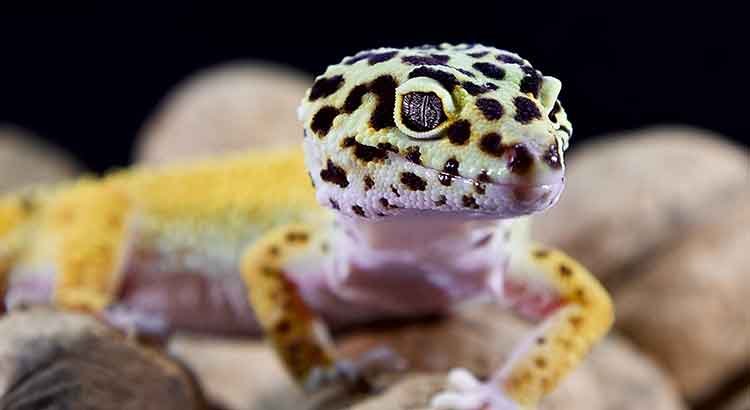Are your leopard geckos showing signs of eye discomfort? Understanding Leopard Gecko Eye Infections is crucial for their well-being.
Leopard gecko eye infections can stem from various factors such as poor hygiene, substrate irritation, or underlying health issues. Prompt diagnosis and proper treatment are essential to prevent complications and ensure your pet’s comfort.
Explore the simple steps to keep your leopard gecko’s eyes healthy and learn how to identify early signs of infection. Your gecko’s well-being relies on your knowledge and proactive care.
Symptoms
Leopard geckos suffering from eye infections may display various symptoms. Watch out for signs like swelling around the eye area, redness, or discharge. Sometimes, affected geckos might keep their eyes closed for extended periods or exhibit excessive blinking.
Additionally, you may notice your gecko rubbing its eyes against surfaces within its enclosure. These behaviors could indicate discomfort or irritation in the eyes. It’s essential to monitor your gecko closely for any changes in behavior or appearance to detect potential eye issues early.
Causes
Several factors can contribute to eye infections in leopard geckos. Poor hygiene within their enclosure, such as dirty substrate or contaminated water, creates a breeding ground for bacteria. Additionally, rough or abrasive substrate materials can irritate the eyes, leading to infections.
Inadequate humidity levels in the gecko’s habitat can also play a role in eye problems. Leopard geckos require a certain level of humidity to maintain proper eye moisture. When humidity levels fall outside of the optimal range, their eyes may become dry and susceptible to infection.
Furthermore, underlying health issues, such as vitamin deficiencies or respiratory infections, can weaken the gecko’s immune system, making them more prone to eye infections. It’s crucial to address any health concerns promptly to prevent secondary complications affecting their eyes.
Treatment
When treating a leopard gecko’s eye infection, it’s crucial to consult with a reptile veterinarian for proper diagnosis and guidance. Depending on the severity of the infection, your vet may prescribe topical antibiotics or other medications to alleviate symptoms and clear the infection.
In addition to medication, maintaining a clean and hygienic enclosure is essential for the gecko’s recovery. Regularly clean and disinfect the habitat to prevent the spread of bacteria and minimize the risk of reinfection. Ensure the substrate is clean and free from debris that could irritate the gecko’s eyes further.
Prevention
Preventing eye infections in leopard geckos involves proactive measures to maintain a healthy environment and address potential risk factors. Start by ensuring the gecko’s habitat is clean and properly maintained at all times. Regularly clean and disinfect the enclosure, including substrate, decorations, and water dishes.
Maintain optimal humidity levels in the gecko’s habitat to prevent dry eyes, which can make them more susceptible to infections. Provide a shallow dish of clean water for drinking and ensure it’s refreshed regularly to prevent bacterial growth. Avoid using abrasive substrate materials that could irritate the gecko’s eyes.
Regularly monitor your leopard gecko for any signs of eye irritation or infection, such as swelling, redness, or discharge. Promptly address any health concerns by consulting with a reptile veterinarian. By maintaining good hygiene practices and addressing potential risk factors, you can help prevent eye infections and promote your gecko’s overall well-being.
FAQ
Q: Can I treat my leopard gecko’s eye infection at home without consulting a veterinarian?
A: It’s not recommended to treat your gecko’s eye infection at home without consulting a veterinarian first. Eye infections can have various causes, and proper diagnosis is crucial for effective treatment. Your vet can prescribe the appropriate medication and provide guidance on care.
Q: How can I tell if my leopard gecko has an eye infection?
A: Watch out for symptoms such as swelling, redness, discharge, or changes in behavior, such as rubbing their eyes. If you notice any signs of eye discomfort or irritation, it’s essential to monitor your gecko closely and consult with a veterinarian for proper evaluation.
Q: What should I do if my leopard gecko’s eyes are stuck shut?
A: If your gecko’s eyes are stuck shut, it could indicate a severe infection or underlying health issue. Do not attempt to force their eyes open. Instead, gently mist their eyes with lukewarm water to help soften any crust or discharge. Then, seek immediate veterinary care for further evaluation and treatment.
Q: How can I prevent eye infections in my leopard gecko?
A: To prevent eye infections, maintain a clean and hygienic enclosure, including regular cleaning and disinfection. Ensure optimal humidity levels and provide clean, fresh water at all times. Avoid using abrasive substrate materials and monitor your gecko’s health regularly for any signs of eye irritation.
Q: Can eye infections in leopard geckos spread to other reptiles or pets?
A: While some eye infections may be specific to leopard geckos, others can potentially affect other reptiles or pets in the same environment. It’s essential to practice good hygiene and quarantine any sick animals to prevent the spread of infections. Consult with a veterinarian for guidance on disease management and prevention strategies.
Final Thoughts
Taking care of your leopard gecko’s eye health is essential for their overall well-being. By staying vigilant and proactive, you can help prevent eye infections and ensure a happy, healthy life for your pet. Remember to maintain a clean and hygienic enclosure, monitor for any signs of eye irritation, and consult with a veterinarian at the first sign of trouble.
Regular veterinary check-ups are crucial for detecting any underlying health issues early and addressing them promptly. Your veterinarian can provide valuable guidance on proper husbandry practices, including habitat setup, diet, and hygiene, to help prevent eye infections and other health problems in your leopard gecko.
By being attentive to your gecko’s needs and providing proper care and attention, you can enjoy a rewarding relationship with your pet for years to come. Whether it’s ensuring a comfortable habitat, addressing health concerns promptly, or seeking professional advice when needed, your efforts are instrumental in promoting your leopard gecko’s happiness and longevity.

